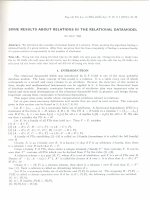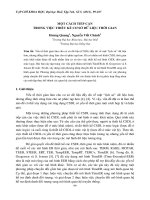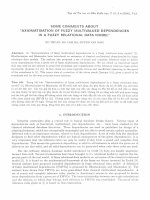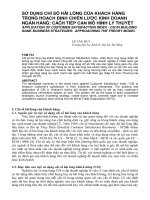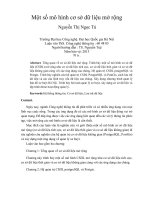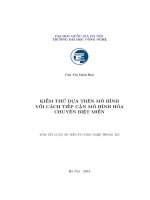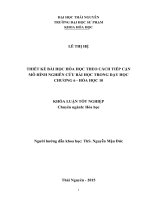Một cách tiếp cận mở rộng mô hình cơ sở dữ liệu quan hệ để xử lý thông tin không đầy đủ và các phụ thuộc dữ liệu. pot
Bạn đang xem bản rút gọn của tài liệu. Xem và tải ngay bản đầy đủ của tài liệu tại đây (3.86 MB, 7 trang )
Ti!p chi Tin
hoc va
Dieu khie'n
hoc,
T.17, S.3 (2001), 41-47
AN APPROACH TO EXTENDING THE RELATIONAL
DATABASE MODEL FOR HANDLING INCOMPLETE
INFORMATION AND DATA DEPENDENCIES
HO THUAN, HO CAM HA
Abstract.
In this paper we propose a new approach to extending the relational database model. This
approach is based on the concept of similarity based fuzzy relational database and somewhat of new viewpoint
on redundancy. It is shown that, in such an extended database model, we can capture imprecise, uncertain
information. The formal definition of fuzzy functional and multivalued dependencies in this study allows
a sound and complete set of inference rules. This paper describes an ongoing work. We state some open
problems to be solved in order to render our approach more operational.
T6m
t~t.
Bai bao de xuat mi?t each tiep c~n m&i
M
m& ri?ng me hlnh err s& dir li~u quan h~. Cach tiep
c~n nay du-a tren khii niern err s& dir li~u mer tircng t~· va mi?t quan die'm mo-i ve duo th ira dir li~u. V&i me
hlnh err S6-dir li~u nhir v~y co the' nitm bitt dtro'c nhirng thong tin khong chinh xac, khOng chltc chan. Dinh
nghia ve phu thuoc ham mer va phu thuoc da tri mer trong bai bao cho m9t t~p cac lu~t suy din xac ding
va
diy dii.
1. INTRODUCTION
Database systems have been extensively studied since Codd [3] proposed the relational data
model. Such database systems do not accept uncertain and imprecise data. In fact, the value of an
object's attribute may be completely unknown, incompletely known (i.e., only a subset of possible
values of the attribute is known)' or uncertain (e.g. a probability or possibility distribution for its value
is known). In addition, the attribute may not be applicable to some of the objects being considered
and, in certain cases, we may not known whether the value even exists, or not. Many approaches
to that problem have been proposed. One of them is "A fuzzy representation of data for relational
database" [2], which is suggested by P. Buckles and E. Petry. In [2] a structure for representing
inexact information in the form of a relational database is presented. The structure differs from
ordinary relational database in two important respects: value of an attribute of an object need not
be single value and a similarity relation is required for each domain set of the database. In a fuzzy
database proposed by these authors, a tuple is redundant if it can be merged with another through the
set union of corresponding domain values. The merging of tuple, however, is subject to constraints
on some similar thresholds. Within this conception, in a fuzzy relation with no redundant tuples
and each domain similarity relation formulated according to Tl transitivity, each tuple represents
information of an object, and each value of an attribute (called
domain value)
consists of one or more
elements from the domain base set. At this point, there is an emphatic notice that elements of each
domain value must be similar enough to each other (i.e. similarity degree of every couple of elements
is not less than the given threshold).
The work reported here is quite distinct from that of P. Buckles and E. Petry in that the elements
of each domain value are not required to be similar enough according to the threshold. This idea
allows each domain value to contain elements, which even are not very similar and represent the
possibilities that can be happened. Therefore, to model a relational database
by
using this approach
will preserve not only the exact information but also the nuances of fuzzy uncertainty.
This paper is organized as follows. Notations and basic definitions related to fuzzy relational
data model and similarity relation, are reviewed in Section 2 to get an identical understanding of
terminology. A new definition about tuple redundant is presented in Section 3. Section 4 contains
42
HO THUAN, HO CAM HA
definition of functional dependency in this scene. The soundness and completeness of the set of
axioms, which is similar with Amstrong's axioms in the traditional relational database, will be proved
in this section. In Section 5, we propose a formal definition of fuzzy multivalued dependency and the
inference rules.
2.
BACKGROUND
First, similarity relations are described as defined by Zadeh
[9].
Then the basic concepts of fuzzy
relational database model are reviewed.
Similarity relations are useful for describing how similar two elements from the same domain are.
Definition 2.1. ([5])
A similarity relation,
SD
(x, y),
for a given domain
D,
is a mapping of every pair
of elements in the domain onto the unit interval [0,1] with the three following properties,
"Ix,
y,
zED:
1. Reflexivity
SD(X,X)
=
1
2. Symmetry
SD(X,y)
=
SD(Y,X)
3.
Transitivity
SD(X,Z) ~ Max(Min[SD(x,y),SD(Y'z)])
Y
SD (x, z)
=
Max([SD
(x, y)
*
SD (y, z)])
Y
or
3'.
Transitivity
(T1)
(T2)
where
*
is arithmetic multiplication)
For each domain
j
in a relational database, a domain base set
D
j
is understood. Domains for fuzzy
relational databases will be either discrete scalars or discrete numbers drawn from either a finite or
infinite set. A domain value
d
ij
,
where
i
is the tuple index, is defined to be a subset (not empty) of
its domain base set
D
j
.
Let
2
D
j
denote a set of any non-null member of the powerset of
D
j
.
Definition
2.2. ([2]) A fuzzy relation, r, is a subset of the set cross product 2Dl
X "" " X
2Dm.
Definition
2.3. ([2]) A fuzzy relation tuple,
t,
is any member of 2Dl x "
X
2Dm.
An arbitrary tuple is of the form ti
E
r, ti
=
(d
i1
, d
i2
, ,dim), dij ~ Dj .
For example:
Name
Car.color
Job
{John}
{green, blue, pink}
{doctor, physician, dentist, farmer}
3. REDUNDANCY AND DETERMINANCY PROPERTIES
In a nonfuzzy database, a tuple is redundant if it is exactly the same as another tuple. In fuzzy
database of P.Buckles and E.Petry [2], a tuple is redundant if it can be merged with another without
violating
LEVEL(Dj)
=
THRES(Dj)'
J"
=
1,2, , m, where
THRES(Dj)
=
mini{minx,YEdij
[s(x,
y)]}
[2]
In a given domain
D
j
,
x, Y
E
D
j
,
if
s(x, y) ~
LEVEL(Dj) then we write down
x ~ y.
Obviously, ~
is a binary relation on
D
j .
Lemma 3.1. ~
is an equivalence relation.
Proof. "Ix
E
D
j
,
s(x, x)
=
1, so
s(x, x) ~
LEVEL(Dj), we have
x ~ x.
Symmetry property of ~ relation is easily implied from the symmetry property of a similarity measure.
V
x, y, z
E
D
j
,
if
s(x, y) ~
LEVEL(Dj) and
s(y, z) ~
LEVEL(Dj), from (T1) transitivity we have
s(x, z) ~
LEVEL(Dj).
Thus, ~ is an equivalence relation and induces a unique partition in
D
j
.
In a fuzzy relational scheme suggested by Buckles and Petry [2], each domain value may consist
of many elements, all of which belong to the same equivalence class partitioned by the ~ relation.
AN APPROACH TO EXTENDING THE RELATIONAL DATABASE MODEL
43
According to these authors, two tuples are redundant to each other if on every attribute, the domain
value of each tuple includes representatives of the same equivalence class. To a certain meaning, if
we consider an equivalence class (of the ~ relation) as a branch of possibilities that may happen,
the model of P. Buckles and E. Petry will allow only to capture information of the objects, of which
the known information about each attribute belongs to only one branch of possibilities. The branch
of possibilities mentioned here is considered to be shown by values, which are, although not equal
to each other, but closed enough to each other according to the measure of a similarity relation.
However, in fact there can be uncertain information about an object, on an attribute of that there
are many possibilities which are far different to each other. In the above example, John may be a
doctor, a physician, a dentist (or any position in medical profession), but John may be also a farmer.
John has a green car, or a pink one, but he may have two cars, one is blue and the other is pink.
And it is not excluded that John has all the three cars which are green, blue and pink. If a group of
possibility branches is considered necessary to keep as it identifies a full information in this case, the
model in [2] should be expanded, and we have tried to do this. Suppose that with each Dj there is a
LEVEL(Dj) for an identified similarity on this domain, two tuples are said to be redundant to each
other if they have the same group of possibilities on each attribute.
Definition
3.1. In fuzzy relation r, two tuples
ti
=
(d
il
,
d
i2
, , dim)
and
tk
=
(d
kl
,
d
k2
, ,
d
km
),
i
=1=
k
are redundant if
't/x
E
d
ij
3x' E
d
kj
:
x ~ x',
VJ
=
1,2, ,
m and vice versa, i.e.
't/x
E
d
kj
3x' E d
ij
:
z ~
x', V
J
=
1,2, ,
m.
As
t,
and
tk
are equitable in the above definition, the notation
ti
RJ
tk
is used to denote that
t;
and
tk
are redundant.
Lemma 3.2.
RJ is an equivalence relation on the fuzzy relation
r.
Proof.
It is clear that, for every tuple
ti
of r,
t,
RJ
ti
from reflexivity of ~ relation.
Obviously, if
ti
RJ
tk
then
tk
RJ
ti .
Suppose that
ti
RJ
tk
and
tk
RJ
tho
Consider arbitrary domain
D
j
,
if
x
E
d
ij
then
3x'
E
d
kj
:
x ~ x'
(from
t,
RJ
tk).
Since
x'
E
d
kj
,
we have
3x"
E
d
hj
:
x' ~ z"
(from
tk
RJ
th).
We also have
z ~
z"
by
transitivity of ~ relation. Similarly, if
x
E
d
hj
we have
3x"
E
d
ij
:
x ~
z",
Thus, redundant
(RJ)
is an equivalence relation on R and induces a unique partition in r.
An example of a fuzzy relation with similarity relations:
r1
Name
Car .color Job
John
green, blue, pink
actor, teacher
Johan
black, magent
aconductor, instructor
Elina
white, pink
artist
Melia
pink, light-milk artist
Tom
black, red
pilot
Fig.
1.
A fuzzy relation
If it is assumed that LEV(Name)
=
0.6 then ~ relation partitions Dom (Name) by three equivalence
classes:
{John, Johan}; {Elina, Melina}; {Tom}
It is also assumed that LEV(Car_color) and LEV(Job) are given such that
Domj Car.color]
and Dom( Job) are partitioned as follow
{{green, blue, black}, {pink, magenta, red}, {white, lighLmilk}}
{{actor, conductor, artist}, {teacher, instructor}, {pilot}}
44
HO THUAN, HO CAM HA
Thus in r1 above,
tl
is redundant for
tz
and
t3
is redundant for
t4 .
John
Johan Elina Melina Tom
John
1.0
0.6
0.0 0.0
0.0
Johan
0.6
1.0
0.0 0.0
0.0
Elina
0.0 0.0
1.0
0.8 0.0
Melina
0.0 0.0 0.8
1.0
0.0
Tom
0.0
0.0 0.0 0.0
1.0
Fig.
2. Similarity relation for Dom(Name)
4. FUZZY FUNCTIONAL DEPENDENCY AND A SET OF SOUND
AND COMPLETE INFERENCE RULES
Let r is a fuzzy relation with m attributes, these according to m domains
D
I
,
D
z
, ,
D
m
,
we
said that r. is an instance of
R,
which is called a relation scheme on
U, U
=
{AI, A
z
, , Am}.
Suppose that X is a set of attributes (X ~
U),
two tuples
tl, tz
E
r,
tl
=
(d
ll
,
dvz, ,
dIm)
and
tz
=
(d
ZI
'
dzz, , d
zm
),
we said
tl, tz
are redundant each other on X and write
tdX] ~ tz[X]
if
Vx
E
d
lj
:lx'
E
d
Zj
: x, , x',
and vice versa, i.e.
Vx
E
d
Zj
:lx'
E
d
lj
:
x, , x',
Vj :
Aj
E
X.
Definition
4.1. A fuzzy functional dependency X ~ Y is said to be hold in a fuzzy relation r if
for every pairs of tuple
tl, tz
E
r:
tdX] ~ tz[X]
implies that
tdY] ~ tz[Y].
In what follows we assume that we are given a fuzzy relational schema with set of attribute U, the
universal set of attributes, and a set of fuzzy functional dependencies
F
involving only attributes in
U.
The inference rules, which similar with Amstrong's axioms are:
FFD1 :
Reflexivity
If Y ~ X then X ~ Y
FFD2:
Augmentation
If X ~ Y holds, then
XZ ~ YZ
holds
FFD3:
Transitivity
If X ~ Y and Y ~
Z
hold, then X ~
Z
holds
Lemma
4.1.
The set of
FFD
axioms
(FFD1-FFD3)
are sound. That is, if
X ~ Y
is deduced from
F
using the axioms, then
X ~ Y
is true in any relation in which the dependencies of
F
are true.
Proo].
(FFD1)
(FFD2)
The reflexivity axiom is clear sound.
Suppose
tl,
t2
E
r such that
tl[XZ] ~ tz[XZ]
then by definition of "~" we have
tdX] ~ tz[X].
From X ~ Y we have
tdY] ~ tz[Y]
(2)
(1) means
Vx
E
d
l
)
:lx'
E
d
z
) : x, , x',
and vice versa
Vj :
D
j
E
XZ.
(2) means
Vx
E
d
lj
:lx'
E
d
Zj
: x, , x',
and vice versa
VJ' :
D)
E
Y.
So we have
Vx
E
d
lj
:lx'
E
d
z
):
z
>«
x',
and vice versa
VJ':
Dj
E
YZ.
It means
XZ ~ YZ.
(1)
(FFD3)
If tl[X] ~
tz[X]
then we have tl[Y] ~
tz[Y]
from X ~ Y
and
tdZ] ~ tz[Z]
from Y ~
Z.
The following inference axioms are infered from the above axioms
AN APPROACH TO EXTENDING THE RELATIONAL DATABASE MODEL
45
FFD4:
Union
If
X ~ Y
and
X ~ Z
hold, then
X ~ Y Z
holds.
FFD5 :
Decomposition
If
X ~ Y
Z
holds, then
X ~ Y
and
X ~
Z
hold.
FFD6 :
Pseudo transitivity
If
X ~ Y
and
YW ~
Z
hold, then
XW ~
Z
holds.
Procedure of proof for the completeness of above inference axioms is very similar to the classical case.
Theorem 4.1.
The set of axioms
(FFDI-FFD2)
are sound and complete.
5. FUZZY MULTIVALUED DEPENDENCY AND SET OF INFERENCE RULES
In the fuzzy paradigm, let
R
be a relation scheme and let
X
and
Y
be subsets of
R.
In a relation
r, an instance of
R,
for X-value
z
we define
Xr(x)
=
{x'l::3t
E
r, such that
t[X]
=
x', x ~ x'}.
Yr(x)
=
{YI::3t
E
r, such that
t[X]
E
Xr(X), try]
=
y}.
Let
Z
=
R - XY.
It is clear that
Yr(x)
is independent of Z-values. We say that
Yr(x)
is equivalent
to
Y
r
(xz)
if for every y of one, there is existing
y'
of the other such that
y ~ y'
and vice versa. The
fuzzy equivalence of two set
Y
-value
(Y
r
(x)
and
Y
r
(xz))
can be reperesented as
Y
r
(x) ~ Y
r
(xz).
Definition 5.1. A
fuzzy multivalued dependency (FMVD) m on a scheme
R,
is a statement m :
X ~
Y,
where
X,
Yare subsets of
R.
Let
Z
=
R - XY.
A relation r on the scheme
R
obeys the
FMVD
m:
X ~ Y
if for every XZ-value
xz
that appears in r we have
Yr(x) ~ Yr(xz).
Example:
r2
X
(Degree)
a,
b,
c
a', c'
a,
c'
a',
c
Y
(Courses)
g,
h
s',
i
g,
i'
s',
h'
Z
(Student)
zl
z2
zl'
z2'
Fig.
9. A fuzzy relation
xl
=
{a,
b,
c},
Xr(xl)
=
{{a,
b,
c},
{a',
c'},
{a,
c'},
{a',
c}}
Yr(xl)
=
{{g,h}, {g',i}, {g,i'}, {g',h'}}
Yr(xlzl)
=
{{g, h}, {g,
i'}}
It is assumed that:
a ~
b ~
a'
9 ~
g'
zl ~ zl'
c "'"
c' ;
h ~ h';
i ~
i';
z2 ~ z2'.
Therefore
{g',i} ~ {g,i'},
{g',
h'} ~
{g,
h},
so
Yr(xl) ~ Yr(xlzl),
and by similar reasoning we must have
Yr(xl) ~ Yr(xlz2).
We say fuzzy multivalued
X ~ Y
is satisfied in r2.
We now propose the set of fuzzy functional and multivalued dependencies inference rules over a
set of atributes
U.
The first three for fuzzy functional dependencies are repeat here.
AI:
Reflexivity for fuzzy functional dependencies
(FFD)
If
Y ~ X
then
X ~ Y.
A2:
Augmentation for
FFD
If
X ~ Y
holds, then
XZ ~ Y Z
holds.
A3:
Transitivity for
FFD
If
X ~ Y
and
Y ~ Z
hold, then
X ~ Z
holds.
46
HO THUAN, HO CAM HA
A4:
Complementation for fuzzy multivalued dependencies
(FMVD)
If X ~
Y
holds, then X ~
Z,
where
Z
=
R - XY.
A5:
Augmentation for
FMVD
If X ~
Y
holds, then X
Z ~ Y Z
holds.
A6:
Transitivity for
FMVD
If X ~
Y
and
Y ~ Z
hold then X ~
(Z - Y)
holds.
Last two axioms that relate fuzzy functional and fuzzy multivalued dependencies are also similar to
classical cases.
A7: If X ~
Y
holds, then X ~
Y.
A8: If X ~
Y
holds,
Z ~ Y, W
n
Y
=
0,
and
W ~ Z,
then X ~
Z
holds.
Lemma 5.1.
The set of axioms
(AI-A8)
are sound. That is, if the fuzzy dependency
(FFD or
FMVD)
is deduced from a set of
FFDs
and
FMVDs, G,
using the axioms, then it is true in any
relation in which the dependencies of G are true.
Proof.
By Lemma 4.1, the axioms AI-A3 is sound.
(A4)
Complementation for fuzzy multivalued dependencies
(FMVD)
If X ~
Y
holds, then X ~
Z,
where
Z
=
R - XY.
We shall prove that, if for every X Z-value
xz
that appears in r we have
Y(x) ~ Y(xz)
then
Z(x) ~
Z(xy)
for every XY-value
xy
that appears in r. Obviously,
Z(xy) ~ Z(x).
Therefore, we only need
to show
v
Zo(Z (x)
::Jz'
E
Z (xy) : Zo
f'::J
z'.
(*)
Let
t, to
E
r, where
t
=
(x, y, z),
to
=
(xo, YO,zo).
Since
Zo
E
Z(x),
we have
Xo
f'::J
x,
which implies,
y
E
Y(xo).
On the other hand
Y(xO) ~ Y(xozo),
we have also
::Jtl
=
«
XI,YI,ZI)
E
r
such that
YI
E
Y (xozo)
and
Y
f'::J
YI.
It means that
Xo
f'::J
Xl,
Zo
f'::J
Zl
and
Y
f'::J
YI.
By transitivity of equivalence
relation
(f'::J),
we get
x
f'::J
Xl'
Consider tuple
t
l
,
we found the existing of
z'
in
(*)
is pointed (let
t'
=
td,
i.e. r satisfies X ~
Z.
(A7) If X ~
Y
holds, then X ~
Y.
We need to show
Y(x) ~ Y(xz)
Vt
=
(x, Y, y)
E
r .
(** )
Let
Yo
E
Y (x),
clearly
Xo
f'::J
x.
Because X ~
Y
is valid in r, we have
Yo
f'::J
y.
It is easy to see that
Y
E
Y(xz)
and
Yo
f'::J
y.
The proof is complete.
(A8): If X ~
Y
holds,
Z ~ Y, W
n
Y
=
0,
and
W ~ Z,
then X ~
Z
holds.
Assume the contrary that we have a fuzzy relation r in which X ~
Y
and
W ~ Z
hold, where
Z ~ Y, W
n
Y
=
0
but X ~
Z
does not hold.
Thus,
::Jtl, t2
E
r such that
(tdX]
f'::J
t2[X])
is true but
(tdZ]
f'::J
t2[Z])
is not valid.
(* * *)
Obviously
t2[Y]
E
Y(tdX]),
from
h[X]
f'::J
t2[X],
Since X ~
Y
holds then
::Jt3
E
r : t3[Y]
E
Y(tdX] tdR - XY])
and
t3[Y]
f'::J
t
2
[Y],
which implies
t3[X]
f'::J
tdX]'
t3[R - XY]
f'::J
tdR - XY],
t3[Y]
f'::J
t2[Y]'
(1)
(2)
(3)
From
W
n
Y =
0,
combining with (1) and (2), we have
t3[W]
f'::J
tdW]. (4)
From
Z ~ Y
and (3), we have also
t3[Z]
f'::J
t2[Z],
Since our contrary assumption
(* * *)
and transitivity of equivalence relation
(f'::J),
it can be seen that
(t3[Z]
f'::J
tl[Z])
does not hold in
r
(5).
But (4) and (5) contradicts
W ~ Z
holds in
T.
The proof is complete.
AN APPROACH TO EXTENDING THE RELATIONAL DATABASE MODEL
47
Proof of (A5) easy to show from definition of FMVD and properties of equivalence relation
(R:j).
Techniques of proof for (A6) are similar to those used in [4].
We also suppose that procedure of proof for the completeness of above inference axioms is similar to
the classical case.
6.
CONCLUSIONS
We have suggested the structure for representing uncertain information in the form of relational
database. The models, which are given by B. P. Buckles and F. E. Petry [2] and by A. K. Mazumdar
[1,6]' are only special cases. Based on the concept of redundancy on a set of tuples, the definitions of
fuzzy dependencies (fuzzy functional dependency and fuzzy multivalued dependency) are proposed.
It is interesting to note that the set of inference rules, which is similar to classical case [7], is sound
and complete as well.
In order to continue, we have already begun some studies: research for extending the relational
algebra in this model, and extension of this model such that it allows the presence of null values too.
REFERENCES
[1] Bhattacharjee T. K, Mazumdar A. K., Axiomatisation of fuzzy multivalued dependencies in a
fuzzy relational data model,
Fuzzy Sets and Systems
96
(1998) 343-352.
[2] Buckles B. P and Petry E., A fuzzy representation of data for relational databases,
Fuzzy Sets
and Systems
1
(1980) 213-226.
[3] Codd E. F., A relational model of data for large shared data banks,
Commun. ACM
13
(6)
(1970) 377-387.
[4] Ho Thuan, Ho Cam Ha, Huynh Van Nam, Some comments about "Axiomatisation of fuzzy
multivalued dependencies in a fuzzy relational data model",
Journal of Computer Science and
Cybernetics
16
(4) (2000) 30-33.
[5] Petry E. and Bose P.,
Fuzzy Databases Principles and Applications,
Kluwer Academic Publish-
ers, 1996.
[6] Raju K. V. and Mazumdar A. K., Functional Dependencies and lossless join decomposition of
fuzzy relational database system,
ACM Trans, Database System
13
(1988) 129-1966.
[7] Ullman
J.
F.,
Principles of Database Systems,
2nd Ed, Computer Science Press, Rockvill, MD,
1984.
[8] Zadeh L. A., Fuzzy sets,
Inform. Control
12 (1965) 338-353.
[9] Zadeh L. A., Fuzzy sets as a basis for a theory of possibility,
Fuzzy Sets and Systems
1 (1978)
3-28.
Received April 10, 2001
Revised July 2, 2001
Ho Thuan - Institute of Information Technology, NCST of Viet Nam
Ho Cam Ha - The Hanoi Pedagogical Institute
